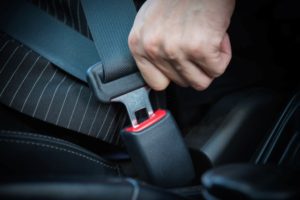
Car seat belts: protection proven for decades
Content
Despite the high speed of development of modern technologies, seat belts remain the main means of passive protection of the driver and passengers in the car. By fixing the position of the body during severe impacts, this device has been proven for decades to help avoid serious injuries, which are very often incompatible with life. According to statistics, in 70% of cases, people manage to survive in serious accidents thanks to seat belts.
Facts from history and modernity
It is believed that the first seat belt was invented and patented in 1885 by the American Edward Claghorn. Initially, the device was used for passengers traveling in open carriages. Later, coachmen also began to use the belt. However, in the automotive industry, seat belts began to appear much later. At the beginning of the twentieth century, they tried to implement them as an additional option, but the idea never caught on.
For the first time, Ford began to mass equip its cars with seat belts: in 1948, new devices were installed in several models of this brand at once.
In their modern form, seat belts appeared in cars only in 1959, when the Swedish concern Volvo began to install them.
In modern vehicles, seat belts are an integral part. While driving, it is necessary to fasten them not only to the driver, but also to each of the passengers in the car. If this rule is violated, the driver will be fined 1 rubles (based on clause 000 of the Code of Administrative Offenses of the Russian Federation).
However, it is not monetary penalties at all, but concern for their own safety obliges drivers and passengers to use a passive safety device that has been proven for years. In the event of a frontal collision, the belts prevent the possibility of:
- departure through the windshield;
- hitting the steering wheel, dashboard, or front seats.
Severe side impacts may cause the machine to roll over. There are cases when unfastened people flew out through the side windows, and then were crushed by the car body. If the seat belts are used as intended, then this situation will not occur.
Any unsecured object in the passenger compartment is a collision hazard for other passengers. People and pets are not an exception.
The device and the principle of operation
At first glance, the construction of a seat belt may seem extremely simple. Nevertheless, the device of modern belts includes a fairly large list of elements, including:
- tension tape (made of high-strength polyester fibers that can withstand heavy loads);
- fasteners (most often installed on body elements for a more reliable fixation, with the exception of cars with four- and five-point belts that are attached to the seat);
- belt buckle (provides a detachable fastening point, thanks to which a convenient laying of the straps is possible);
- inertial reels (responsible for the correct tension of the belt tape and its winding when unfastening);
- limiters (allow you to smoothly increase the length of the belt in order to extinguish energy and increase safety at the time of an accident);
- pretensioners (triggered at the moment of impact, instantly tightening the belt and preventing acceleration of the body).
The complete list of elements depends on the mechanism of the belt. In total, there are three principles of device operation:
- Static mechanism. This type of design is obsolete and is not used on modern cars. The tape has a specific length that you can manually adjust. Due to non-compliance with safety standards, belts of this type are out of service.
- Dynamic mechanism. Such belts can lengthen and unwind evenly as a person moves. However, during hard braking, a retainer is triggered, due to which the belt tightly presses the body against the car seat, keeping the driver or passenger stationary.
- Leading mechanism. The most reliable and modern option associated with other vehicle security systems. If special sensors in the car detect the possibility of a dangerous situation, the electronics tightens the belts in advance. When the danger has passed, the tape returns to its normal position.
Types of modern seat belts
As safety belts began to be introduced into the automotive industry, manufacturers began to offer different types of these devices. As a result, several categories of belts can be found in modern cars:
- Two-point belts are an obsolete option. Such devices are most common in passenger buses and airplanes. Sometimes two-point belts are fitted to the rear seats of cars for the passenger sitting in the middle.
- The three-point belt is an option familiar to most car owners. It is also called diagonal belt. It features reliable fixation and is universal (suitable for both the front and rear row of seats in any car).
- Four-point belts are not widely used. Most often they are used on sports cars, special equipment, and sometimes off-road vehicles. The strap attaches to the seat at four points, keeping the person from tipping over or hitting hard.
- Five-point belts are used only in expensive supercars, as well as in the construction of child restraints. In addition to the shoulder and waist bindings, there is another strap between the passenger's legs.
operating rules
Using the seat belt is as simple and convenient as possible for the driver and passengers. However, even this simple device has its own rules and nuances of operation.
- To check if the seat belt is tight enough, stick your hand between the belt belt and your body. If there is a noticeable compression on the hand, it means that it is stretched to the right extent.
- Do not twist the tape. In addition to the obvious inconvenience, such operation of the belt will not provide it with proper tension in an emergency.
- If the car was sent for repair after a serious accident, ask the service specialists to pay attention to the seat belts. As a result of strong and sharp tension, the belts could lose their strength. It is possible that they need to be replaced, and also to check the reliability of fastening of all elements of the device.
- Replacement of seat belts is also recommended during accident-free driving at intervals of 5-10 years due to natural wear and tear.
Many motorists try to loosen the belt so that it does not hinder movement. However, an unreasonably low tension significantly reduces the braking effect of the device, as a result of which its effectiveness is significantly reduced.
These statistics say: if a person ignores the need to use a seat belt in a car, then in the event of an accident, the risk of serious injury will increase:
- 2,5 times - in a head-on collision;
- 1,8 times - with a side impact;
- 5 times - when the car rolls over.
The road can be completely unpredictable, so at any time, seat belts can save your life.
